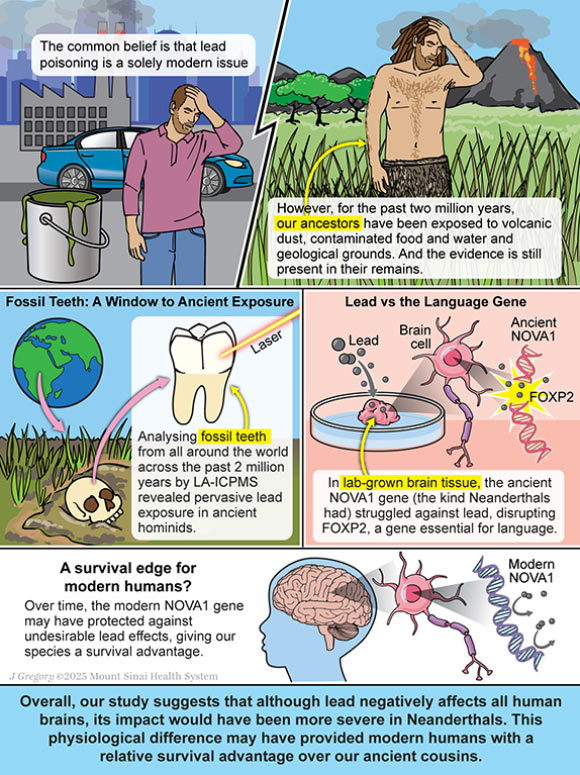Several hominids — Australopithecus africanus, Paranthropus robustus, early Homo sp., Gigantopithecus blacki, Pongo sp., Papio sp., Homo neanderthalensis, and Homo sapiens — were consistently exposed to lead over 2 million years, contradicting the idea that lead exposure is solely a modern phenomenon, according to a new analysis of fossil teeth from regions in Africa, Asia, Oceania, and Europe.

Lead exposure to humans in modern times versus our ancestors. Image credit: J. Gregory / Mount Sinai Health System.
“Our data show that lead exposure wasn’t just a product of the Industrial Revolution — it was part of our evolutionary landscape,” said Professor Renaud Joannes-Boyau, a researcher at Southern Cross University.
“This means that the brains of our ancestors developed under the influence of a potent toxic metal, which may have shaped their social behavior and cognitive abilities over millennia.”
Using precise validated laser ablation micro spatial sampling protocols, the authors analyzed 51 fossil samples from Australopithecus africanus, Paranthropus robustus, early Homo sp., Gigantopithecus blacki, Pongo sp., Papio sp., Homo neanderthalensis, and Homo sapiens.
They found clear signals of episodic lead exposure in 73% of the specimens (71% for hominins Australopithecus, Paranthropus, and Homo).
Some of the geologically oldest samples — Gigantopithecus blacki estimated to be from the early (1.8 million years ago) and middle Pleistocene (1 million years ago) — show repeated events of lead exposure separated by periods of negligible lead uptake.
The researchers also turned to the lab to explore how this ancient exposure might have affected brain development.

Australopithecus africanus. Image credit: J.M Salas / CC BY-SA 3.0.
Using human brain organoids (miniature, lab-grown models of the brain), they compared the effects of lead on two versions of a key developmental gene called NOVA1, a gene known to orchestrate gene expression upon lead exposure during neurodevelopment.
The modern human version of NOVA1 is different from that found in Neanderthals and other extinct hominids, but until now, scientists did not know why this change evolved.
When organoids carrying the archaic NOVA1 variant were exposed to lead, they showed marked disruptions in the activity of FOXP2 — expressing neurons in the cortex and thalamus — brain regions that are critical for the development of speech and language.
This effect was far less pronounced in organoids with the modern NOVA1 variant.
“These results suggest that our NOVA1 variant may have offered protection against the harmful neurological effects of lead,” said University of California San Diego’s Professor Alysson Muotri.
“It’s an extraordinary example of how an environmental pressure, in this case, lead toxicity, could have driven genetic changes that improved survival and our ability to communicate using language, but which now also influence our vulnerability to modern lead exposure.”

An artist’s impression of a group of Gigantopithecus blacki within a forest in southern China. Image credit: Garcia / Joannes-Boyau, Southern Cross University.
Genetic and proteomic analyses in the study revealed that lead exposure in archaic-variant organoids disrupted pathways involved in neurodevelopment, social behavior, and communication.
The altered FOXP2 activity in particular points to a possible link between ancient lead exposure and the evolutionary refinement of language abilities in modern humans.
“This study shows how our environmental exposures shaped our evolution,” said Professor Manish Arora, a researcher at Icahn School of Medicine at Mount Sinai.
“From the perspective of inter-species competition, the observation that toxic exposures can offer an overall survival advantage offers a fresh paradigm for environmental medicine to examine the evolutionary roots of disorders linked to environmental exposures.”
The study was published in the journal Science Advances.
_____
Renaud Joannes-Boyau et al. 2025. Impact of intermittent lead exposure on hominid brain evolution. Science Advances 11 (42); doi: 10.1126/sciadv.adr1524







